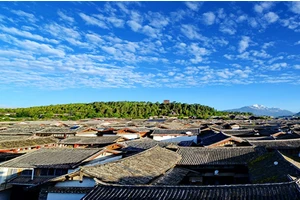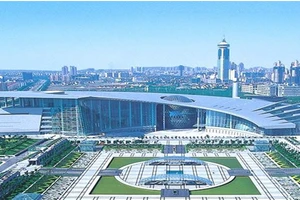Haidong tourism resources
Haidong City, Qinghai Province, located in the northeast of Qinghai Province, China, is a prefecture-level city under the jurisdiction of Qinghai Province.
Haidong City borders Gansu Province in the east, Haibei Tibetan Autonomous Prefecture in the northwest, Xining City in the west and Huangnan Tibetan Autonomous Prefecture in the south. Located on the northeast edge of the Qinghai-Tibet Plateau, it is a mosaic zone for the transition from the Loess Plateau to the Qinghai-Tibet Plateau. The topography of Haidong city is mainly mountainous, and the topography generally shows a pattern of high in the east and low in the west. There are Daban Mountain, a branch of Qilian Mountain, and Sun Moon Mountain, a residual vein of Kunlun Mountain, which are between 1650 meters and 2835 meters above sea level.
Rivers mainly include the Yellow River and Huangshui River, which form a vast valley plain in the territory and are important bases for agricultural production in Haidong City. Haidong City is an important agricultural area in Qinghai Province and the birthplace of Hehuang civilization. On February 8, 2013, with the approval of the State Council, Haidong District was revoked to establish a prefecture-level Haidong City, which governs Ping 'an County, Minhe Hui and Tu Autonomous County, Huzhu Tu Autonomous County, Hualong Hui Autonomous County, Xunhua Salar Autonomous County and the newly established Ledu District.
Introduction of tourist attractions in Haidong City:
1. Beishan National Forest Park
Beishan National Forest Park is a 4A-level scenic spot in Haidong, located next to Zhalonggou, Zhalv Highway, Huzhu Tu Autonomous County, Haidong City. The park is rich in forest resources, including all kinds of rare plants and wild animals. The park is a natural green treasure house with undulating mountains and lush vegetation. There are many scenic spots in the park, such as Nanquan Lake, Beishan Waterfall and Forest Bath, which attract a large number of tourists.
2. Huzhu Tuzu Homeland Park
Huzhu Tuzu Homeland Garden is a major tourist attraction in Haidong City, including five core attractions: the source of China highland barley wine, Rainbow Tribe Tuzu Garden, Nadun Manor, Western Tuzu Folk Culture Village and Xiaozhuang Tuzu Folk Culture Village. Among them, the Rainbow Tribe Tu Garden shows the colorful folk culture of Tu nationality, Nadun Manor attracts tourists with its quaint and mysterious architecture and unique folk culture, and Xiaozhuang Tu folk culture village shows the traditional folk culture of Tu nationality.
Reference to the above content: Baidu Encyclopedia-Haidong City
Overview of rich resources in Haidong city
Haidong City is located at the southern foot of Daban Mountain, a branch of Qilian Mountain, and the eastern slope of Sun Moon Mountain in Kunlun Mountain System, which belongs to the transitional area between the Loess Plateau and the Qinghai-Tibet Plateau, with an altitude ranging from 1650 to 2835 meters. The climate here belongs to plateau climate, with the characteristics of cold and drought, long sunshine time, high solar radiation intensity and significant temperature difference between day and night. The annual average temperature is 6.9℃, the annual precipitation is 323.6 mm, and the evaporation is as high as 1644 mm.
In terms of mineral resources, Haidong is rich in limestone (about 2 billion tons), glauberite (more than 2.7 billion tons), gypsum (more than 2.6 billion tons), quartzite (about 1.2 billion tons), dolomite (200 million tons), and coal (about 6 million tons), pyrite (2.8 million tons) and oil shale (16 million tons). In addition, gold, iron, aluminum, copper, nickel, chromium, zinc, platinum, asbestos, fluorite, graphite, mica, red silica, calcite, barite, jade and other minerals also have mining value. Haidong has thus become an important mineral base.
In terms of hydraulic resources, Haidong has abundant hydropower resources of Yellow River, Datong River and Huangshui River, and it is planned to build 49 large, medium and small hydropower stations with an installed capacity of 6.21 million kilowatts. The 27 power stations that have been built have provided 4.48 million kilowatts of electricity, making Haidong an important energy supply place in Qinghai. Perfect power facilities, such as Minhe's Asia's largest 750KV substation and the projects being planned, as well as several substations with different voltage levels, constitute the key channel for Qinghai's power transmission from west to east.
In terms of agricultural resources, Haidong is the main agricultural area in Qinghai Province, with 3.24 million mu of cultivated land, rich in crops such as wheat, highland barley and peas, as well as agricultural products such as oil, melons and vegetables. Rich soil and convenient irrigation provide a good environment for the growth of crops and cash crops, and it is an important grain and animal husbandry base in Qinghai Province.
In terms of tourism resources, Haidong is characterized by its natural ecology, history and culture, and has ecological resorts such as Mengda Nature Reserve and Huzhu Beishan National Forest Park, as well as Tu and Salar cultures with national characteristics. In addition, cultural attractions and religious sites along the Yellow River, such as Qutan Temple and Wendu Temple, also attract tourists. Rich human landscape resources, including Lajia site and Liuwan cemetery, have important academic and archaeological value.
In terms of animal husbandry, the Hehuang Valley in Haidong is a traditional place for grazing, with 11.5 million mu of natural grassland, developed aquaculture, 4.65 million heads of livestock (only) per year, and considerable meat production.
Extended data
Haidong City is located in the northeast of Qinghai Province, and Haidong is named after being located in the east of Qinghai Lake. The whole territory is about 124.5 kilometers long from east to west, between 100 41.5' and 103 04' east longitude; It is about 180 kilometers wide from north to south, between 35 25.9 ′ and 37 05 ′ north latitude. The total area of the city is 13,160 square kilometers. The east is adjacent to Tianzhu, Yongdeng, Lanzhou, Yongjing, Linxia and Gannan in Gansu Province, and the other three sides are adjacent to Haibei, Huangzhong and Huangnan in Gansu Province. On February 8, 2013, the State Council approved Qinghai Province to cancel Haidong area and set up Haidong City as the youngest prefecture-level city in China.
Prev: Dushan town travel






